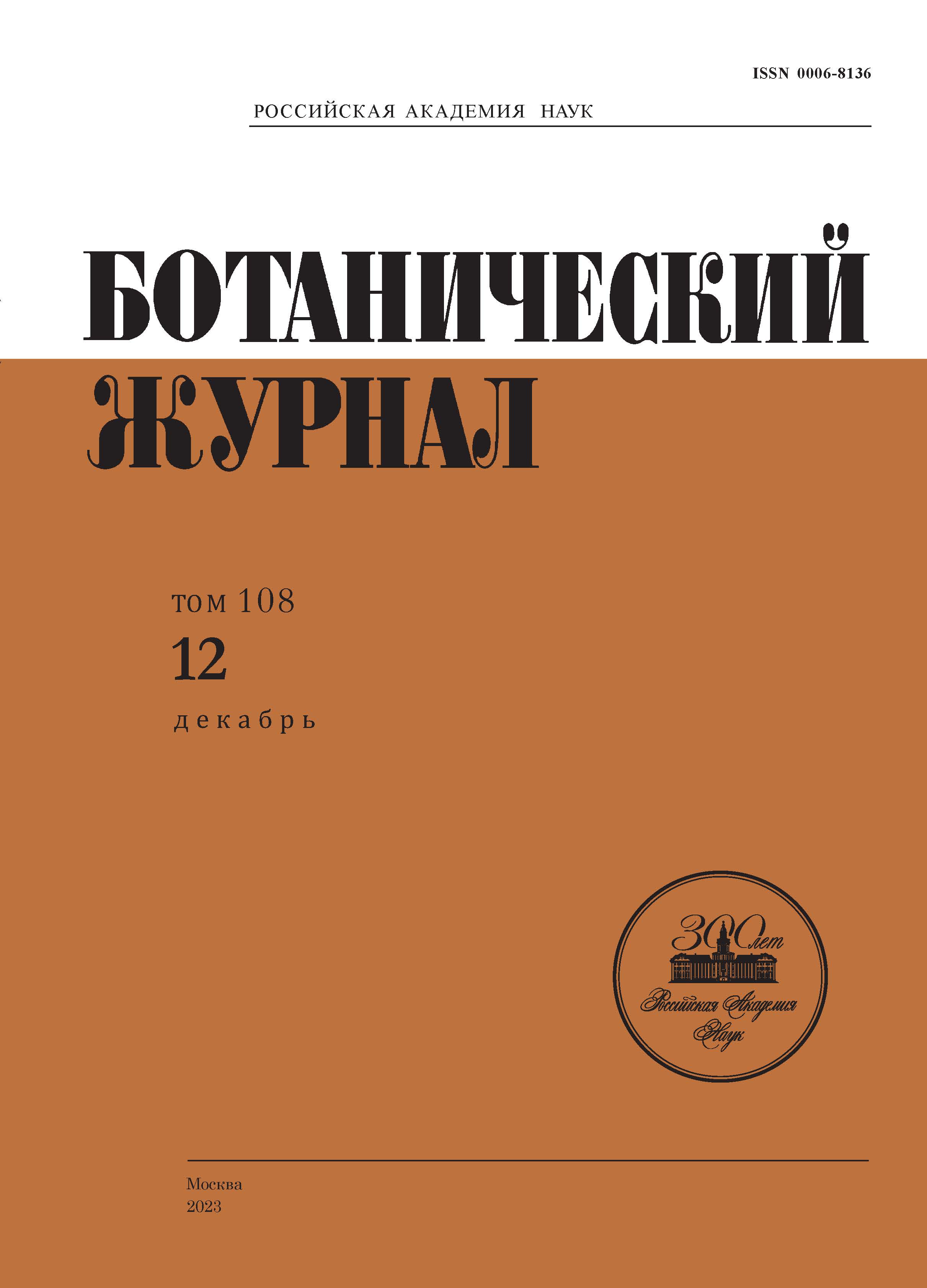GYNODIOECY IN GERANIUM PSEUDOSIBIRICUM (GERANIACEAE)
- Authors: Gordeeva N.I.1, Komarevceva E.K.1
-
Affiliations:
- Central Siberian Botanical Garden, Siberian Branch of the Russian Academy of Sciences
- Issue: Vol 108, No 12 (2023)
- Pages: 1093-1099
- Section: COMMUNICATIONS
- URL: https://rjmseer.com/0006-8136/article/view/666406
- DOI: https://doi.org/10.31857/S0006813623120049
- EDN: https://elibrary.ru/DCCQDQ
- ID: 666406
Cite item
Abstract
A breeding system of the gynodioecious Geranium pseudosibiricum J. Mayer in three meadow and meadow-steppe communities of the Altai Mountains was investigated. Statistically significant differences in the morphology of flowers between hermaphrodite and female plants have been established (p < 0.001). The stamens of pistillate flowers in females are reduced and do not produce pollen. Statistically significant differences between the sexes in seed productivity have been established: female plants form several times more fruits than hermaphrodite ones (p < 0.01); a high female compensation was detected for G. pseudosibiricum. Infertile hermaphrodite plants were found in the coenopopulations. Female palnts in the coenopopulation CP1 constitute 55% of the total number of generative plants. In natural habitats, G. pseudosibiricum is characterized by good seed breeding and successful formation of offspring, which contributes to the maintenance of female plants in the coenopopulations of the species. The features of breeding system of G. pseudosibiricum have revealed significant differences between female and hermaphrodite plants.
Keywords
About the authors
N. I. Gordeeva
Central Siberian Botanical Garden, Siberian Branch of the Russian Academy of Sciences
Author for correspondence.
Email: nataly.gordeeva@gmail.com
Russia, 630090, Novosibirsk, Zolotodolinskaya Str., 101
E. K. Komarevceva
Central Siberian Botanical Garden, Siberian Branch of the Russian Academy of Sciences
Author for correspondence.
Email: elizavetakomarevceva@yandex.ru
Russia, 630090, Novosibirsk, Zolotodolinskaya Str., 101
References
- Abdusalam A., Tan D., Chang S.M. 2017. Sexual expression and reproductive output in the ephemeral Geranium transversale are correlated with environmental conditions. – Am. J. Bot. 104 (12): 1920–1929. https://doi.org/10.3732/ajb.1700258
- Asikainen E., Mutikainen P. 2003. Female frequency and relative fitness of females and hermaphrodites in gynodioecious Geranium sylvaticum (Geraniaceae). – Am. J. Bot. 90 (2): 226–234. https://doi.org/10.3732/ajb.90.2.226
- Chang S.M. 2006. Female compensation through the quantity and quality of progeny in a gynodioecious plant, Geranium maculatum (Geraniaceae). – Am. J. Bot. 93 (2): 263–270. https://doi.org/10.3732/ajb.93.2.263
- Charlesworth B., Charlesworth D. 1978. A model for the evolution of dioecy and gynodioecy. – Am. Naturalist. 112: 975–997. https://www.jstor.org/stable/2460344
- Charlesworth D. 2006. Evolution of plant breeding systems. – Current Biology. 16 (17): R726–R735. http://doi.org/10.1016/j.cub.2006.07.068
- Darwin C. 1897. The different forms of flowers on plants of the same species. – D. Appleton. 352 p.
- Dem’yanova E.I. 1985. Distribution of gynodioecy in flowering plants. – Bot. Zhurn. 70 (10): 1289–1301 (In Russ.).
- Dem’yanova E.I. 2011. The spectrum of sexsual types and forms in the local floras of the Urals (Cis- and Trans-Urals). – Bot. Zhurn. 96 (10): 1297–1315 (In Russ.). https://elibrary.ru/download/elibrary_16919798_14353005.pdf
- Dem’yanova E.I., Ponomarev A.N. 1079. The sex structure of natural populations gynodioecious and dioecious plants of forest-steppe of Zauralye. – Bot. Zhurn. 64 (7): 1017–1024 (In Russ.).
- Glantz S. 1998. Primer of biostatistics. Transl. from English. Moscow. 459 p. (In Russ.). http://medstatistic.ru/articles/glantz.pdf
- Gordeeva N.I. 2020. Gynodioecia of Geranium bifolium (Geraniaceae). – Bot. Zhurn. 105 (3): 86–92 (In Russ.). https://doi.org/10.31857/s0006813620030035
- Gordeeva N.I. 2021. Sexual and ontogenetic structures of gynodioecious Geranium pseudosibiricum J. Mayer (Geraniaceae) in Altai Mountains. – BIO Web of Conferences Vol. 38. https://doi.org/10.1051/bioconf/20213800040
- Gordeeva N.I. 2022. Mating systems and seed reproduction in gynodioecious Geranium asiaticum (Geraniaceae). – Dokl. Biol. Sciences. 506: 179–183. https://doi.org/10.1134/S0012496622050039
- Gouyon P.-H., Couvet D. 1988. A conflict between two sexes, females and hermaphrodites. – In: The evolution of sex and its consequences. Birkhauser Verlag, Basel. Switzerland. P. 245–261.
- Knuth P. 1898. Handbuch der Blutenbiologie. Leipzig: Verlag von Wilhelm Engelmann. Bd. II. T. I. S. 228–238.
- Kuznetsova T.V., Pryakhina N.I., Yakovlev G.P. 1992. Sotsvetiya. Morfologicheskaya klassifikatsiya. [Inflorescences. The morphological classification]. St. Petersburg. 127 p. (In Russ.).
- Mordak E.V. 1981. Sem. Geranievye [Family Geraniaceae (Geraniaceae)]. – In: Zhizn’ rasteniy. Vol. 5 (2). Moscow. P. 277–280 (In Russ.).
- Peshkova G.A. 1996. Family Geraniaceae. – In: Flora Siberae. Vol. 10. Novosibirsk. P. 8–22 (In Russ.).
- Spigler R.B., Ashman T.L. 2012. Gynodioecy to dioecy: are we there yet? – Annals of Botany. 109 (3): 531–543. https://doi.org/10.1093/aob/mcr170
- Sugorkina N.I. 1989. Onnogenez i osobennosti populyatsionnoi biologii vidov roda Geran’ [Ontogenesis and features of population biology of species of the genus Geranium]: Abstr. … Diss. Kand. Sci. Moscow. 17 p. (In Russ.).
- Troshkina V.I. 2016. Notes on systematic and chorology of Geranium pseudosibiricum and related species (Geraniaceae). – Rastitelnyy mir Aziatskoy Rossii. 3 (23): 22–32 (In Russ.). https://doi.org/10.21782/RMAR1995-2449-2016-3(22-32)
- Tsenopopulatsii rasteniy: (osnovnyye ponyatiya i struktura) [Plant coenopopulations (basic conceptsand structure)]. 1976. Moscow. 217 p. (In Russ.).
- Varga S., Kytöviita M.M., Siikamäki P. 2009. Sexual differences in response to simulated herbivory in the gynodioecious herb Geranium sylvaticum. – Plant Ecol. 202 (2): 325–336. https://doi.org/10.1007/s11258-008-9492-0
- Webb D.A., Ferguson I.K. 1968. Geraniaceae. – Flora Europaea. 2: 193–204.
- Williams C.F., Kuchenreuther M.A., Drew A. 2000. Floral dimorphism, pollination, and self fertilization in gynodioecious Geranium richardsonii (Geraniaceae). – Am. J. Bot. 87 (5): 661–669. https://doi.org/10.2307/2656852 PMID: 10811790
- Zaitsev G.N. 1991 Matematicheskiy analiz biologicheskikh dannykh [Mathematical analysis of the biological data]. Moscow. 184 p. (In Russ.).
Supplementary files










